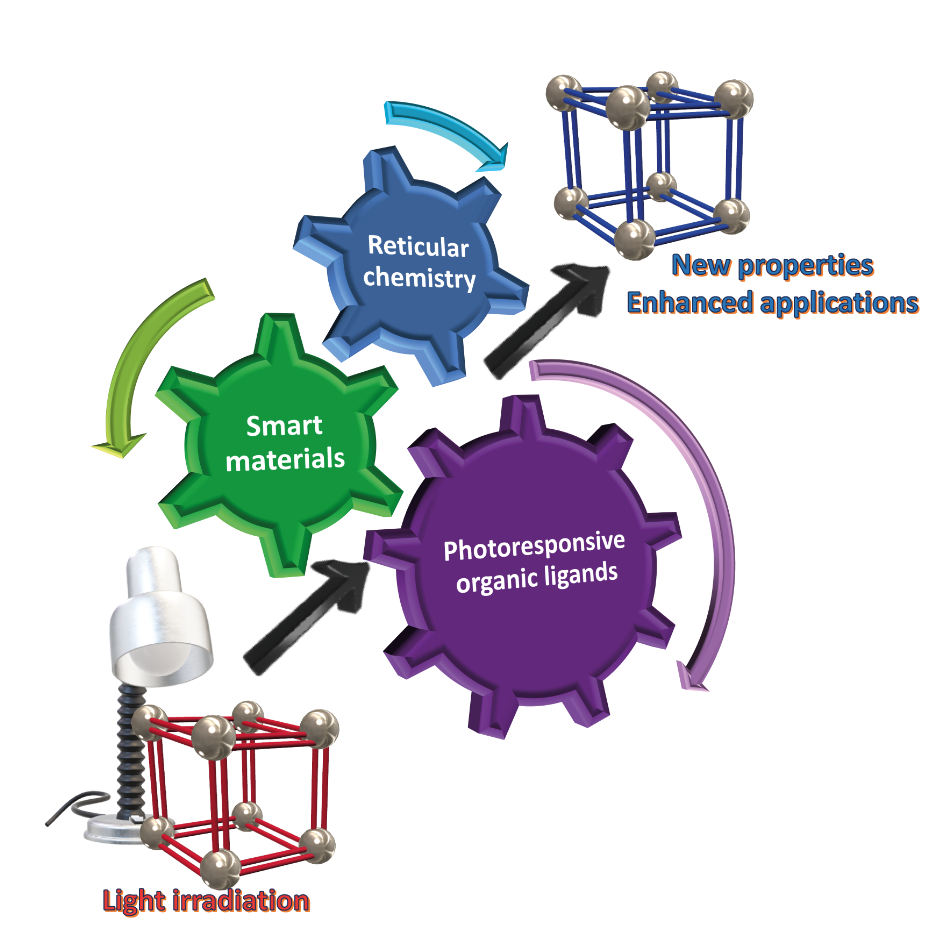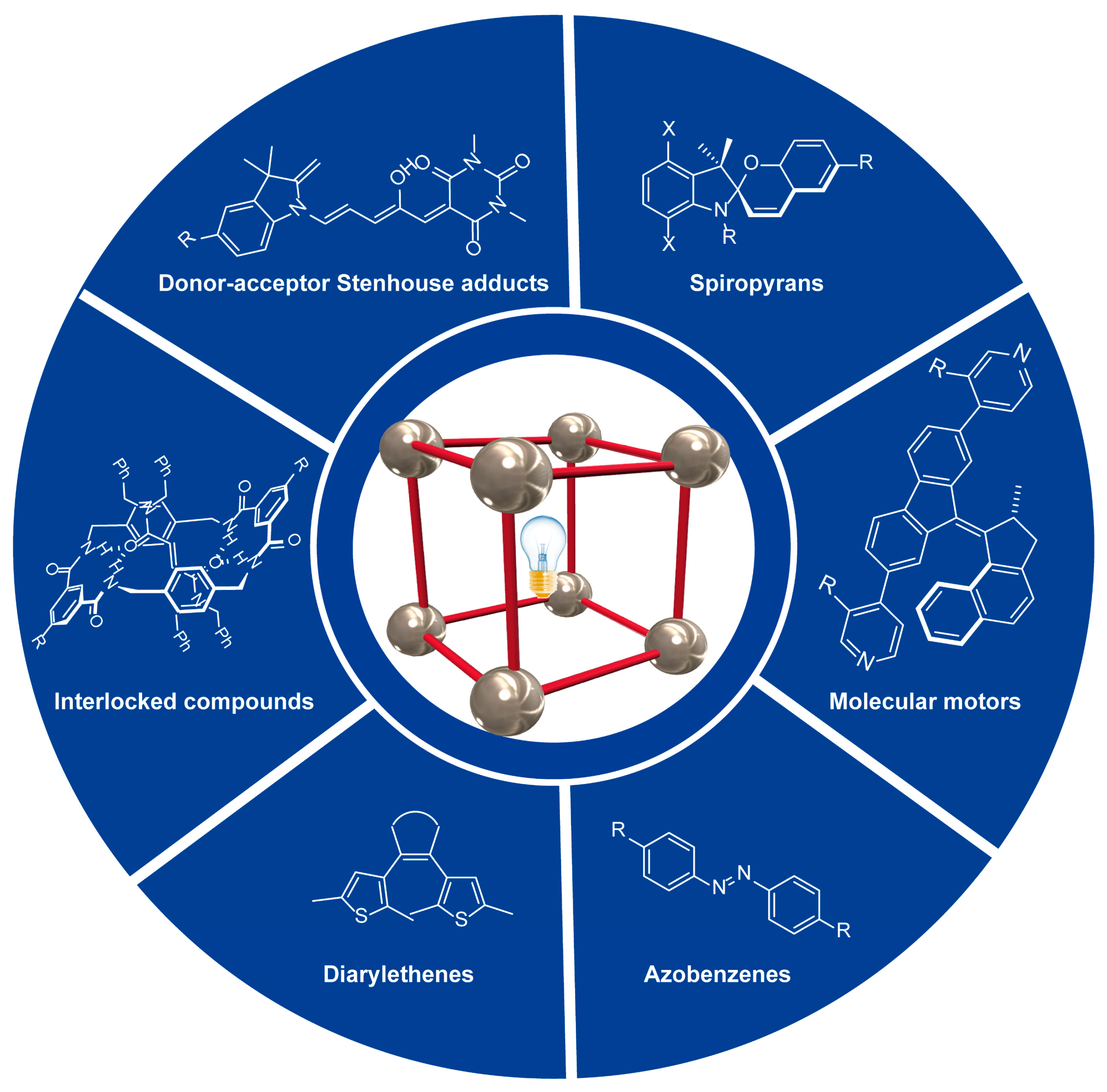Metal-organic frameworks (MOFs) are a type of crystalline porous material having organic ligands connected to metal clusters. This type of material shows a terrific design adaptability due to the almost unlimited combinations of metallic salts and organic ligands. Several scientists have been attracted by this important part of reticular chemistry, probably due to the fact that the researcher’s inventiveness is the only limitation in this research field. Thus, different research groups have greatly contributed to the exponential growth of this area, using these materials in a diverse range of applications, including catalysis, water harvesting, biomedicine and sensing.
The easy and remote switching of light makes this stimulus an ideal candidate for a large number of applications, among which the preparation of photoresponsive materials stands out. The interest of several scientists in this area in order to achieve improved functionalities has increased parallel to the growth of the structural complexity of these materials. Thus, metal-organic frameworks (MOFs) turned out to be ideal scaffolds for light-responsive ligands.
The development of organic ligands having a higher structural complexity is one of the main directions in order to prepare MOFs showing advanced functionalities [
31,
32,
33,
34]. Thus, the incorporation of stimuli-responsive scaffolds inside a MOF matrix turned out to be an ideal strategy within reticular chemistry [
35,
36,
37,
38], allowing to prepare smart materials [
39,
40]. The application of an external stimulus induces changes in the organic ligands, leading to modifications of certain properties of the metal-organic material, such as porosity [
41,
42]. The selected stimulus should be able to promote modifications in the crystalline array without causing damage to its structural integrity.
Among the available stimuli, light is particularly appealing due to: (i) the easy and remote switching control; (ii) the possibility of varying the intensity, wavelength and irradiation time; (iii) the clean and non-destructive operation [
43]. Different organic ligands bearing photoactive units have been employed for the preparation of photoresponsive MOFs [
44,
45,
46].
Figure 1. Cartoon representing the main content of the review.
This short review aims to give an insight in the preparation and application of light-responsive metal-organic frameworks by using different photoswitchable organic ligands, including azobenzenes [
47], diarylethenes [
48], spiropyrans [
49], donor-acceptor Stenhouse adducts (DASA) [
50], molecular motors [
51] and interlocked compounds [
52,53]. For this purpose, some recent advances in the use of the abovementioned organic ligands are highlighted in this manuscript [
53,
62,
63,
68,
70,
75,
76,
78,
85,
87,
113].
Figure 2. Selected photoactive organic ligands employed to prepare light-responsive metal-organic frameworks.
The photoresponsive metal-organic frameworks highlighted in this review are highly important because of their advantageous properties and numerous potential practical applications. Due to the intrinsic porosity that characterizes MOFs, most of them can be applied in selective adsorption or controlled cargo release [
62,
63,
68,
70,
113]. Favorable properties of these materials herald possible applications in other fields, such as Nanorobotics, Data Storage and Optoelectronics [
53,
76,
78,
85,
87]. Most of the currently implemented applications of these photoresponsive MOFs are at the research laboratory level, but an example employed to develop FET and LED devices is also highlighted [
76].
The use of different ligands, such as azobenzenes, diarylethenes, spiropyrans and DASA, has allowed the development of a wide variety of applications. The combination of reticular chemistry and molecular machinery, by incorporating light-responsive molecular motors and rotaxanes inside a MOF matrix, further expands the range of options for the development of photoresponsive materials showing improved functionalities.
The incorporation of photoresponsive molecules within MOFs has led to the preparation of materials which change their properties in response to light irradiation. Thus, different applications, such as selective adsorption and development of optoelectronic devices can be achieved. In order to incorporate this photoswitchable ligands, the well-stablished synthetic protocols for obtaining this type of material have been employed, such as mixed-linker solvothermal conditions and SALE methodology [
1,
2]. The vast design possibility forecasts materials in which future prospects are almost limitless. Additionally, the precise modulation of the photochemical stimulus, being able to modify time, wavelength and irradiation power, leads to forecasting a promising future for this field of research.
Photoresponsive metal-organic frameworks have a bright outlook as adjustable scaffolds to prepare smart materials, which makes this area of study really attractive to a wide range of scientists from different research fields. This interdisciplinarity would benefit the progress of these interesting porous materials.
This entry is adapted from the peer-reviewed paper 10.3390/ijms23137121


